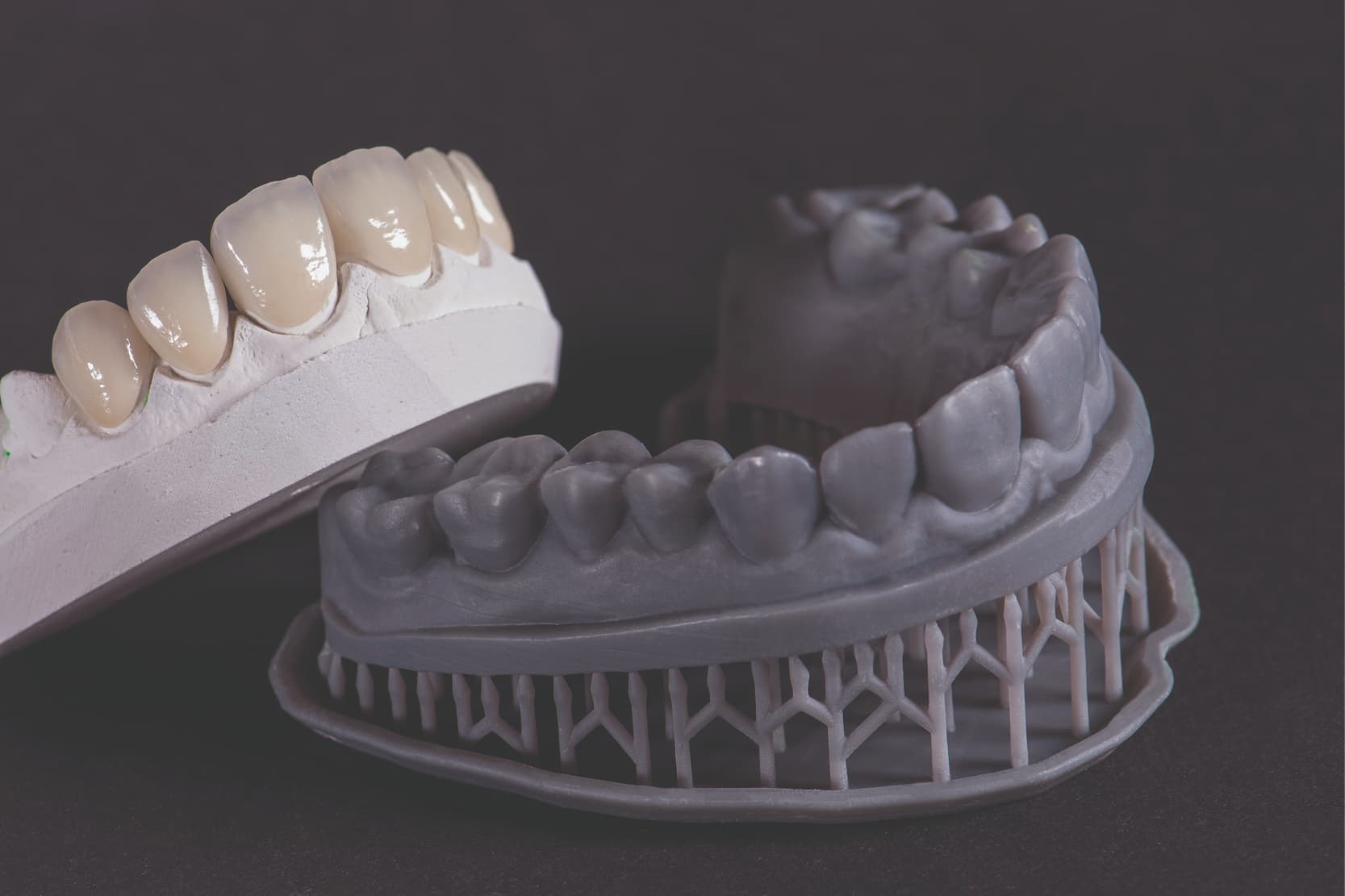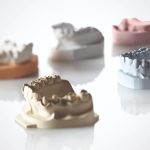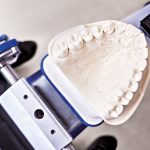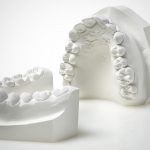12
Jan
Gypsum models vs 3D models that can be printed: characteristics and accuracy factors compared

3D printing is an additive process (AM – Additive Manufacturing) that enables the physical construction of digital models by printing layer upon layer.
It was invented in 1986 when Charles Hull filed the first patent for stereolithography (SLA), which consisted in creating objects in layers by solidifying liquid resin sensitive to the wavelength of ultraviolet light (400 nm).[1] The layers are thus printed one on top of the other to create the 3D object.
Since then, the layered printing process has evolved with different techniques and a plethora of increasing varied and high-performance materials[2,3].
3D printing in the dental sector
With the advent of digital technology and intraoral scanners, 3D printing started to become more widely-utilised in dentistry with a number of uses[4]. Of these, we can certainly recognise the construction of dental models as one of the main applications, in which it is essential for obtaining a physical model from an intraoral scanner STL file[5].
In the past, preparing gypsum models cast using dental impressions made with specific materials (polyvinylsiloxanes, condensation silicones, alginates, polyethers, polysulphides) was the only way to obtain a positive physical model of the patient’s arches[6,7].
The dental technician would then use these analogue models to build the prosthetic framework or the orthodontic/gnathological devices that were subsequently fitted in the patient’s mouth[8].
Gypsum models and models that can be printed
The workflow described above is still valid and is still the gold standard for a number of clinical applications[9,10].
As a matter of fact, while intraoral scanners have achieved a level of accuracy and precision that almost matches, in some cases, those of impression materials, the same cannot be said of 3D printed models, which are generally less accurate than gypsum models[11,12].
Several factors influence the accuracy of 3D printed models and, to date, many of them are still in the study phase.
Errors and accuracy factors of 3D models
The errors introduced in 3D printing can result from:
- digital data acquisition;
- the processing of the images of the hard and soft tissues of the oral cavity;
- the myriad of printing parameters;
- the post-processing that is carried out on each printed object [5].
Indeed, various scientific papers state that the thickness or depth of the layer of resin to be printed, the spacing between the various curing sections, the power of the light, the translucency of the colour of the resin used and the magnitude of overcuring, strongly influence the accuracy of 3D printing[13,14].
The angle of construction of the object, its geometry and the parameter settings of the supports, which are always necessary to prevent the deformation of the objects being printed, are also important factors[15].
Furthermore, the models acquired through the curing of liquid resin are all subject to contraction during the curing phase[16,17].
The contraction of 3D printing resins is usually significant, given the almost total absence of fillers that is necessary to allow the resin to flow easily between the base of the platform and the bottom of the tray with each printing cycle[18]. The magnitude of the contraction is always a function of the amount of resin used.
As a matter of fact, one study on 3D printed dental models concluded that 3D dental models with a hollow base design are more accurate than those with a honeycomb or solid design[19].
The scarcity of fillers in these resins also affects the mechanical properties of the object, which are almost solely determined by the structural rigidity of the monomer composing the resin[18,20,21].
3D printing post-processing
Any 3D printed object then needs to be further processed in order to be usable.
Indeed, immediately after the initial printing, the object will still be part-cured and with rough surfaces covered in semisolid material residues.
The post-processing steps therefore consist in[13]:
- physically removing the printed device from the construction platform;
- cleaning the surface of the object and removing the uncured resin by immersing it in an organic solvent such as isopropyl alcohol (IPA);
- the final curing step to complete the curing of the device using a UV ray machine;
- removing the supporting structures using a cutting device, a diamond disc or an ultrasonic tip.
During these procedures, the 3D printed object may be improperly handled by the dental technician and undergo changes that could affect both its accuracy and final mechanical properties.
One solution to this problem was provided by Dentsply Sirona with PrimePrint[22,23] in which the automation of post-processing allows the technician/practitioner to handle the object only once it is completely cured, in order to remove the supports.
Accuracy factors of gypsum models
With respect to all the variables described above, the production of gypsum models is certainly more standardised, although their accuracy is affected by factors such as[24,25]:
- the proportions of water/powder used;
- the mixing of the gypsum (automatic under vacuum or manual);
- the contact time between the impression material and the gypsum;
- the exposure of the gypsum to temperature and humidity conditions that are such to determine the conversion of sulphate bihydrate into hemihydrate.
- the thickness of the light impression material, which has lower resistance during the volumetric expansion of the gypsum.
The costs of the different models
A direct comparison between the two types of models must, of course, necessarily also consider their costs.
These are some of the main disadvantages of 3D printing technologies that, compared to the analogue techniques (gypsum) still have very high costs, not only with regard to the machines/printers, but also with regard to the materials (resins in particular).
Even amongst the CAD-CAM technologies, making a rapid comparison with classic numerical control (CNC) milling, although 3D printing is certainly the most promising technology, it is still very expensive.
It is also important to consider the initial cost of the software and the learning curve for mastering the user of the slicer (the function used by the software to convert an STL file into the 3D printing specifications in order to produce the object, including its position in the construction platform, the direction of printing and the supports)[13].
In this sense, the use of gypsum material is very simple and inexpensive, relinable, and dimensionally stable even for long periods of time[26,27], another characteristic in respect of which 3D resins have significant limits, especially three weeks after printing[28].
The clinical application of analogue and 3D models
Amongst the various models that can be produced with 3D printing or gypsum it is also important to consider their clinical applications; dental models for orthodontics can have discrepancy levels of up to 500 µm compared to the corresponding STL file[5].
Values that are decidedly unacceptable when fabricating restorations on natural teeth or implants[29,30]. And, considering the differences in terms of the accuracy and precision of the 3D printers on the market, it is fundamental to know and choose those that are best suited to the clinical requirements[5].
Conclusions
However promising and interesting these new technologies may be from the clinical application perspective, at the current time (2022), the traditional analogue workflow involving the fabrication of gypsum models is still the gold standard because it is predictable and has been clinically validated for many years.
It will undoubtedly be interesting to see whether and how this might change in the future with the evolution of increasingly high-performance technologies.
References:
[1] Masri R, Driscoll C. Odontoiatria digitale: Presupposti teorici e applicazioni cliniche. Edra; 2017.
[2] Kalberer N, Mehl A, Schimmel M, Müller F, Srinivasan M. CAD-CAM milled versus rapidly prototyped (3D-printed) complete dentures: An in vitro evaluation of trueness. J Prosthet Dent 2019;121:637–43. https://doi.org/10.1016/j.prosdent.2018.09.001.
[3] Anadioti E, Musharbash L, Blatz MB, Papavasiliou G, Kamposiora P. 3D printed complete removable dental prostheses: a narrative review. BMC Oral Health 2020;20:343. https://doi.org/10.1186/s12903-020-01328-8.
[4] Dawood A, Marti Marti B, Sauret-Jackson V, Darwood A. 3D printing in dentistry. Br Dent J 2015;219:521–9. https://doi.org/10.1038/sj.bdj.2015.914.
[5] Etemad-Shahidi Y, Qallandar OB, Evenden J, Alifui-Segbaya F, Ahmed KE. Accuracy of 3-Dimensionally Printed Full-Arch Dental Models: A Systematic Review. J Clin Med 2020;9:E3357. https://doi.org/10.3390/jcm9103357.
[6] Millstein PL. Determining the accuracy of gypsum casts made from type IV dental stone. J Oral Rehabil 1992;19:239–43. https://doi.org/10.1111/j.1365-2842.1992.tb01098.x.
[7] Butta R, Tredwin CJ, Nesbit M, Moles DR. Type IV gypsum compatibility with five addition-reaction silicone impression materials. J Prosthet Dent 2005;93:540–4. https://doi.org/10.1016/j.prosdent.2005.04.006.
[8] The Glossary of Prosthodontic Terms: Ninth Edition. J Prosthet Dent 2017;117: e1-e105 n.d.
[9] van Noort R. The future of dental devices is digital. Dent Mater Off Publ Acad Dent Mater 2012;28:3–12. https://doi.org/10.1016/j.dental.2011.10.014.
[10] Srinivasan M, Kamnoedboon P, McKenna G, Angst L, Schimmel M, Özcan M, et al. CAD-CAM removable complete dentures: A systematic review and meta-analysis of trueness of fit, biocompatibility, mechanical properties, surface characteristics, color stability, time-cost analysis, clinical and patient-reported outcomes. J Dent 2021;113:103777. https://doi.org/10.1016/j.jdent.2021.103777.
[11] Park M-E, Shin S-Y. Three-dimensional comparative study on the accuracy and reproducibility of dental casts fabricated by 3D printers. J Prosthet Dent 2018;119:861.e1-861.e7. https://doi.org/10.1016/j.prosdent.2017.08.020.
[12] Choi J-W, Ahn J-J, Son K, Huh J-B. Three-Dimensional Evaluation on Accuracy of Conventional and Milled Gypsum Models and 3D Printed Photopolymer Models. Materials 2019;12:3499. https://doi.org/10.3390/ma12213499.
[13] Piedra-Cascón W, Krishnamurthy VR, Att W, Revilla-León M. 3D printing parameters, supporting structures, slicing, and post-processing procedures of vat-polymerization additive manufacturing technologies: A narrative review. J Dent 2021;109:103630. https://doi.org/10.1016/j.jdent.2021.103630.
[14] Lee SH, Park WS, Cho HS, Zhang W, Leu MC. A neural network approach to the modelling and analysis of stereolithography processes. Proc Inst Mech Eng Part B J Eng Manuf 2001;215:1719–33. https://doi.org/10.1177/095440540121501206.
[15] Alharbi N, Osman RB, Wismeijer D. Factors Influencing the Dimensional Accuracy of 3D-Printed Full-Coverage Dental Restorations Using Stereolithography Technology. Int J Prosthodont 2016;29:503–10. https://doi.org/10.11607/ijp.4835.
[16] Carvalho RM, Pereira JC, Yoshiyama M, Pashley DH. A review of polymerization contraction: the influence of stress development versus stress relief. Oper Dent 1996;21:17–24.
[17] Ling L, Taremi N, Malyala R. A Novel Low-Shrinkage Resin for 3D Printing. J Dent 2022;118:103957. https://doi.org/10.1016/j.jdent.2022.103957.
[18] Tiba A, Charlton DG, Vandewalle KS, Ragain JC. Comparison of two video-imaging instruments for measuring volumetric shrinkage of dental resin composites. J Dent 2005;33:757–63. https://doi.org/10.1016/j.jdent.2005.02.004.
[19] Revilla-León M, Piedra-Cascón W, Methani MM, Barmak BA, Att W. Influence of the base design on the accuracy of additive manufactured casts measured using a coordinate measuring machine. J Prosthodont Res 2022;66:68–74. https://doi.org/10.2186/jpr.JPR_D_20_00198.
[20] Lin C-H, Lin Y-M, Lai Y-L, Lee S-Y. Mechanical properties, accuracy, and cytotoxicity of UV-polymerized 3D printing resins composed of Bis-EMA, UDMA, and TEGDMA. J Prosthet Dent 2020;123:349–54. https://doi.org/10.1016/j.prosdent.2019.05.002.
[21] Gonçalves F, Kawano Y, Pfeifer C, Stansbury JW, Braga RR. Influence of BisGMA, TEGDMA, and BisEMA contents on viscosity, conversion, and flexural strength of experimental resins and composites. Eur J Oral Sci 2009;117:442–6. https://doi.org/10.1111/j.1600-0722.2009.00636.x.
[22] Primeprint | Dental 3D Printer | Dentsply Sirona n.d. https://www.dentsplysirona.com/en-us/discover/discover-by-brand/primeprint.html (accessed October 21, 2022).
[23] Reich S, Berndt S, Kühne C, Herstell H. Accuracy of 3D-Printed Occlusal Devices of Different Volumes Using a Digital Light Processing Printer. Appl Sci 2022;12:1576. https://doi.org/10.3390/app12031576.
[24] Heidari B, Vafaei F, Izadi A, Saleh A, Dehbani Z, Khazaei S. Effect of Contact Time Between Silicone Impression Materials and Stone on Dimensional Stability of Resultant Cast. Avicenna J Dent Res 2013;5:20–5. https://doi.org/10.17795/ajdr-20937.
[25] Nissan J, Laufer BZ, Brosh T, Assif D. Accuracy of three polyvinyl siloxane putty-wash impression techniques. J Prosthet Dent 2000;83:161–5. https://doi.org/10.1016/s0022-3913(00)80007-4.
[26] Adegbulugbe IC, Oderinu OH, Shaba OP, Oremosu OA. Evaluation of linear dimensional stability of various combinations of dental stone and plaster. Niger Q J Hosp Med 2011;21:267–70.
[27] Sweeney WT, Taylor DF. Dimensional Changes in Dental Stone and Plaster. J Dent Res 1950;29:749–55. https://doi.org/10.1177/00220345500290060601.
[28] Joda T, Matthisson L, Zitzmann NU. Impact of Aging on the Accuracy of 3D-Printed Dental Models: An In Vitro Investigation. J Clin Med 2020;9:E1436. https://doi.org/10.3390/jcm9051436.
[29] Revilla-León M, Gonzalez-Martín Ó, Pérez López J, Sánchez-Rubio JL, Özcan M. Position Accuracy of Implant Analogs on 3D Printed Polymer versus Conventional Dental Stone Casts Measured Using a Coordinate Measuring Machine. J Prosthodont Off J Am Coll Prosthodont 2018;27:560–7. https://doi.org/10.1111/jopr.12708.
[30] Banjar A, Chen Y-W, Kostagianni A, Finkelman M, Papathanasiou A, Chochlidakis K, et al. Accuracy of 3D Printed Implant Casts Versus Stone Casts: A Comparative Study in the Anterior Maxilla. J Prosthodont Off J Am Coll Prosthodont 2021;30:783–8. https://doi.org/10.1111/jopr.13335.
Do you want more information on Zhermack Dental products and solutions?
Contact us




 Zhermack SpA has been one of the most important producers and international distributors of alginates, gypsums and silicone compounds for the dental sector for over 40 years. It has also developed solutions for the industrial and wellbeing sectors.
Zhermack SpA - Via Bovazecchino, 100 - 45021 Badia Polesine (RO), Italy.
Zhermack SpA has been one of the most important producers and international distributors of alginates, gypsums and silicone compounds for the dental sector for over 40 years. It has also developed solutions for the industrial and wellbeing sectors.
Zhermack SpA - Via Bovazecchino, 100 - 45021 Badia Polesine (RO), Italy.


